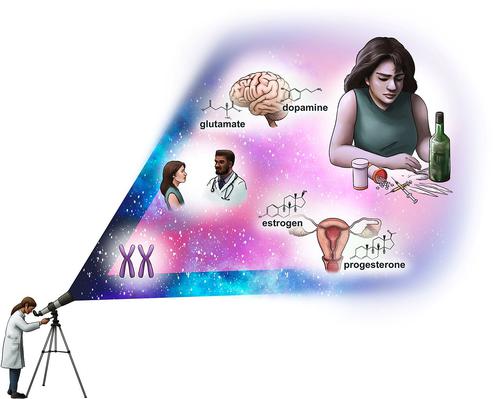当前位置:
X-MOL 学术
›
Pharmacol. Rev.
›
论文详情
Our official English website, www.x-mol.net, welcomes your feedback! (Note: you will need to create a separate account there.)
Sex/Gender Differences in the Time-Course for the Development of Substance Use Disorder: A Focus on the Telescoping Effect
Pharmacological Reviews ( IF 21.1 ) Pub Date : 2023-03-01 , DOI: 10.1124/pharmrev.121.000361 Eleanor Blair Towers 1 , Ivy L Williams 1 , Emaan I Qillawala 1 , Emilie F Rissman 1 , Wendy J Lynch 2
Pharmacological Reviews ( IF 21.1 ) Pub Date : 2023-03-01 , DOI: 10.1124/pharmrev.121.000361 Eleanor Blair Towers 1 , Ivy L Williams 1 , Emaan I Qillawala 1 , Emilie F Rissman 1 , Wendy J Lynch 2
Affiliation

|
Sex/gender effects have been demonstrated for multiple aspects of addiction, with one of the most commonly cited examples being the “telescoping effect” where women meet criteria and/or seek treatment of substance use disorder (SUD) after fewer years of drug use as compared with men. This phenomenon has been reported for multiple drug classes including opioids, psychostimulants, alcohol, and cannabis, as well as nonpharmacological addictions, such as gambling. However, there are some inconsistent reports that show either no difference between men and women or opposite effects and a faster course to addiction in men than women. Thus, the goals of this review are to evaluate evidence for and against the telescoping effect in women and to determine the conditions/populations for which the telescoping effect is most relevant. We also discuss evidence from preclinical studies, which strongly support the validity of the telescoping effect and show that female animals develop addiction-like features (e.g., compulsive drug use, an enhanced motivation for the drug, and enhanced drug-craving/vulnerability to relapse) more readily than male animals. We also discuss biologic factors that may contribute to the telescoping effect, such as ovarian hormones, and its neurobiological basis focusing on the mesolimbic dopamine reward pathway and the corticomesolimbic glutamatergic pathway considering the critical roles these pathways play in the rewarding/reinforcing effects of addictive drugs and SUD. We conclude with future research directions, including intervention strategies to prevent the development of SUD in women.
中文翻译:

药物使用障碍发展时间过程中的性别差异:关注伸缩效应
性/性别效应已在成瘾的多个方面得到证实,最常被引用的例子之一是“伸缩效应”,即女性在吸毒几年后符合标准和/或寻求物质使用障碍 (SUD) 的治疗,如与男性相比。据报道,多种药物类别都存在这种现象,包括阿片类药物、精神兴奋剂、酒精和大麻,以及赌博等非药物成瘾。然而,有一些不一致的报告表明,男性和女性之间没有差异,或者效果相反,并且男性比女性更快上瘾。因此,本次综述的目的是评估支持和反对女性伸缩效应的证据,并确定伸缩效应最相关的条件/人群。我们还讨论了来自临床前研究的证据,这些证据强烈支持伸缩效应的有效性,并表明雌性动物会出现类似成瘾的特征(例如,强迫性吸毒、吸毒动机增强以及吸毒渴望/容易复发) )比雄性动物更容易。我们还讨论了可能有助于伸缩效应的生物因素,例如卵巢激素,及其神经生物学基础,重点关注中脑边缘多巴胺奖励途径和皮质脑边缘谷氨酸途径,考虑到这些途径在成瘾药物的奖励/强化作用中发挥的关键作用和南苏丹。我们总结了未来的研究方向,包括预防女性 SUD 发展的干预策略。
更新日期:2023-02-14
中文翻译:

药物使用障碍发展时间过程中的性别差异:关注伸缩效应
性/性别效应已在成瘾的多个方面得到证实,最常被引用的例子之一是“伸缩效应”,即女性在吸毒几年后符合标准和/或寻求物质使用障碍 (SUD) 的治疗,如与男性相比。据报道,多种药物类别都存在这种现象,包括阿片类药物、精神兴奋剂、酒精和大麻,以及赌博等非药物成瘾。然而,有一些不一致的报告表明,男性和女性之间没有差异,或者效果相反,并且男性比女性更快上瘾。因此,本次综述的目的是评估支持和反对女性伸缩效应的证据,并确定伸缩效应最相关的条件/人群。我们还讨论了来自临床前研究的证据,这些证据强烈支持伸缩效应的有效性,并表明雌性动物会出现类似成瘾的特征(例如,强迫性吸毒、吸毒动机增强以及吸毒渴望/容易复发) )比雄性动物更容易。我们还讨论了可能有助于伸缩效应的生物因素,例如卵巢激素,及其神经生物学基础,重点关注中脑边缘多巴胺奖励途径和皮质脑边缘谷氨酸途径,考虑到这些途径在成瘾药物的奖励/强化作用中发挥的关键作用和南苏丹。我们总结了未来的研究方向,包括预防女性 SUD 发展的干预策略。



























 京公网安备 11010802027423号
京公网安备 11010802027423号